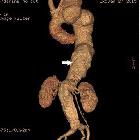Ortner syndrome











 nicht verwechseln mit: Ortner's syndrome II
nicht verwechseln mit: Ortner's syndrome IIOrtner syndrome, also known as cardiovocal syndrome, is characterized by hoarse voice resulting from left recurrent laryngeal nerve palsy secondary to a cardiovascular disorder.
Pathology
Left recurrent laryngeal nerve palsy in this condition is due to traction or compression of the nerve between the thoracic aorta and pulmonary artery . The left recurrent laryngeal nerve arises from the left vagus (X) nerve and passes underneath the aortic arch posterior to the ligamentum arteriosum before it ascends into the left tracheoesophageal groove to reach the larynx .
Etiology
The original description of Ortner syndrome is due to a markedly distended left atrium secondary to mitral stenosis which has a reported incidence of 1.5% to 6% .
Other causes include :
- aortic pathologies (e.g. thoracic aortic aneurysm)
- patent ductus arteriosus
- atrial septal defect
- ventricular septal defect
- recurrent pulmonary embolism
- Eisenmenger syndrome
- primary pulmonary hypertension
History and etymology
It is named after Norbert Ortner (1865-1935), an Austrian physician .
Siehe auch:
- Nervus laryngeus recurrens
- Heiserkeit
- Ortner's syndrome: Ductus Arteriosus aneurysm as a cause of left vocal cord palsy
- Rekurrensparese
und weiter:

 Assoziationen und Differentialdiagnosen zu Ortner-Syndrom 1 - cardiovokales Syndrom:
Assoziationen und Differentialdiagnosen zu Ortner-Syndrom 1 - cardiovokales Syndrom:

